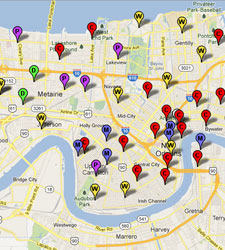Restoration of St. Stephen Church
Restoration or Renovation?
Before any design or assessment work began, Msgr. Nalty was clear that our project should be a restoration and not a renovation. The main objective of the restoration, which includes the cleaning, repointing and repair of all masonry surfaces, is not to make a 19th-century building look brand new. Instead, the work aims to honor the structure’s age and history by reversing previous improper cleaning and repair work and by maintaining as much of the historic fabric of the building as possible.
Beginning with the 2014 initial assessment of the condition of St. Stephen Church, Michael Schoriak and Courtney Williams of Cypress Building Conservation (CBC) have assisted Trapolin-Peer Architects (TPA) as they developed the scope of work for our church. Experts in historic materials and in the cleaning and restoration of historic buildings, CBC has been on site almost daily along with Chris Chimento of TPA to guide and supervise work in progress.
Every single step of the restoration process is guided by the objective that no intervention compromises the historic and material integrity of the 19th-century structure. In order to achieve this objective, restoration methods are informed by an understanding of the physical properties of each historic material.
Under the guidance of CBC and DonahueFavret Contractors, Inc. masons have begun cleaning the entire surface of the exterior with a micro-abrasive system. This system delivers a low-pressure swirl of glass powder to clean the soft historic brick without damaging its surface. It is also used to remove paint build-up from brick, terracotta and sandstone surfaces without damaging the substrate (building material). In contrast, previous cleaning campaigns have used acids and high-pressure rinses, all of which were too harsh for the soft masonry elements and have caused damage.

North Wall Masonry: Bricks, cleaned and old mortar removed,
awaiting new lime based mortar
Once all surfaces are cleaned, all improper cement mortars will be removed at every single mortar joint. In layman’s terms, this means that someone has to scrape/chisel out the mortar around each brick in the entire building. This tedious, hot and messy process is necessary because the hard cement mortar, used over many years for repairs, is incompatible with the historic soft brick. The cement’s hard, impermeable nature traps water inside the brick wall, creating damage to the softer bricks as well as damage to interior finishes.
After brick surfaces have been cleaned and improper cement mortars removed, all joints will be re-pointed using a 100% lime-based mortar. This alleviates the damage cement mortars have caused. As a softer and more permeable material, the lime-based mortar allows the masonry building to “breathe.” Further, the mortar will be matched to the original mortar color, honoring its historic integrity.

This brick, dated Aug 9, 1873, was found near the rose window on
the north wall.
Finally, the decorative terracotta and sandstone elements seen throughout the building will be cleaned and repaired. These elements have degraded as a result of atmospheric pollution and weathering. After cleaning, any large voids will be filled with in-kind materials to reclaim the original shape of the elements. Finally, a “consolidant” will be applied to the surface. This treatment essentially binds the individual components of the stone together in order to decelerate the rate of deterioration caused by weathering. As not all staining can be completely removed by cleaning, some of these elements will be painted to achieve a sense of uniformity throughout the façade.

Clipping from the Times Picayune, dated June 6, 1874, announcing
the new Catholic church on Napoleon Avenue.




